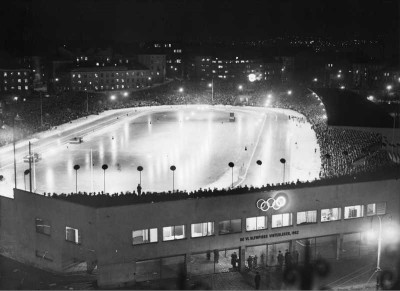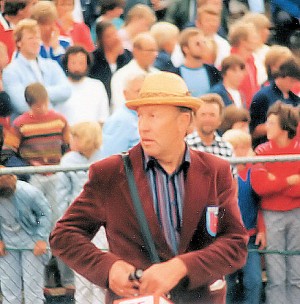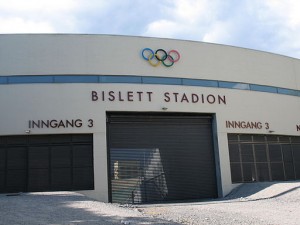UPDATED: As the annual Bislett Games kicked off Thursday evening, their charm and tradition continued to attract the best track and field athletes from around the world – with sprint star Usain Bolt setting a new Bislett record. Sixty-five world records have been set during the games’ 47 years, and Bislett itself remains a popular venue in world athletics.

Crowds filled the grandstands despite chilly temperatures and the threat of more rain. Bolt himself said it was cold, but he managed to run the 200-meter race faster than anyone ever has at Bislett, in 19.79 seconds.
While Norwegian javelin star Andreas Thorkildsen had a disappointing performance, landing in sixth place with his best throw of 80.99 meters, Norwegian sprinter Ezinne Okparaebo logged her best performance this season, running 100 meters in 11.30 seconds. Vitezslav Vesely of the Czech Republic took first place in the javelin event with a throw of 85.96 meters, while Ivet Lalova of Bulgaria won the women’s sprint with a time of 11.04.
The games, held annually at Bislett Stadium in central Oslo, can boast an extraordinary sporting history since they began in 1966. Some of the world’s most famous track and field athletes have set new world records at Bislett, including British athletes Sebastian Coe, Steve Ovett, and Steve Cram, Kenyan Henry Rono and Norwegian marathon runner Grete Waitz. The star attraction again this year was superstar Bolt of Jamaica, who first competed at the games in 2011.
The Bislett Games have, since they began in 1966, been characterized by charisma and drive behind the scenes as well as on the track. They were founded by the legendary Arne Haukvik under the so-called “Bislett alliance,” which brought together three different athletics associations to manage them.

Originally from Telemark county in southern Norway, Haukvik spent his formative years as a vacuum cleaner salesman in Chicago before returning home to Norway and becoming active in both athletics and politics for the Center Party. Newspaper Aftenposten wrote Thursday that it was just after Ron Clarke of Australia set a new world record in the 10,000-meter race in 1965 during competition at Bislett that Haukvik got “the brilliant idea” of creating the Bislett Games.
He did a lot of backroom negotiating over pay for competitors during their early years. “If the weather is good and there are a lot of people, it could be that you get a few more dollars,” he allegedly told star athletes to encourage them. In the days before international sports stars had huge sponsorship deals, or even bank accounts, Haukvik was well known for his brown envelopes of cash. The negotiations could continue right up until the starting gun was fired, and could even be used as an incentive to run faster.
Haukvik was known for wearing his trademark straw hat, often also carrying a megaphone to whip up excitement among the crowds. He also famously held “strawberry parties” for all the athletes, sponsors and press on the day prior to the games’ opening. The parties, in the garden of his East Oslo house, were originally quite informal, with all of the world’s top athletes mingling and socializing with journalists, while munching on Norwegian strawberries. The tradition still continues, in a slightly less informal way.
“Without Arne Haukvik, there would not have been a Bislett Games,” according to Svein Arne Hansen, the man who took over the baton and became director of the games during the 1990s. They continued to attract the world’s top athletes to the games. During Hansen’s leadership, Oslo and Bislett became part of the “Golden Four” of athletics events, alongside Zürich, Brussels and Berlin.

Hansen believes the audience is one of the reasons for the games’ enduring success. “Athletes love the intimate atmosphere, and the ‘Bislett roar’ that has given goosebumps to many a runner,” he told Aftenposten.
In 2004, the old stadium that had hosted the games for 38 years running, was demolished and its original six-lane track that had sharp bends and Bislett’s steep terraces were replaced with a conventional eight-lane track and new seating. The old stadium, built in the 1940s in the functionalist or funkis style, famously hosted the speed skating and figure skating events during the Winter Olympics of 1952. The stadium’s career as a speed skating venue ended in 1988, however, when it was decided that ice production would discontinue. The original stadium became rundown and there was over a decade of debate before the Oslo City Council finally decided that it would be torn down and rebuilt to modern athletic standards.
During the rebuilding, the 2004 games were held at Fana Stadium in Bergen instead, under the name “Bergen Bislett Games,” the only time they were held outside Bislett. The new stadium was, appropriately enough, completed at top speed and finished in less than 10 months, ready to host the games again in the summer of 2005.
The games later became part of the IAAF Golden League. Today they’re sponsored by the giant US oil and gas multinational ExxonMobil. There are huge television deals, and the “ExxonMobil Dream Mile” is one of the key races at the games. According to Hansen, however, the event’s budget is still relatively small.
“We have never had the most money, but the athletes have liked our style,” Hansen said. “Even though today we have a budget nearing NOK 20 million (nearly USD 3.5 million), we’re just a sparrow compared to Zürich, which has a budget of NOK 50 million.”
Views and News from Norway/Elizabeth Lindsay
Please support our news service. Readers in Norway can use our donor account. Our international readers can click on our “Donate” button:

